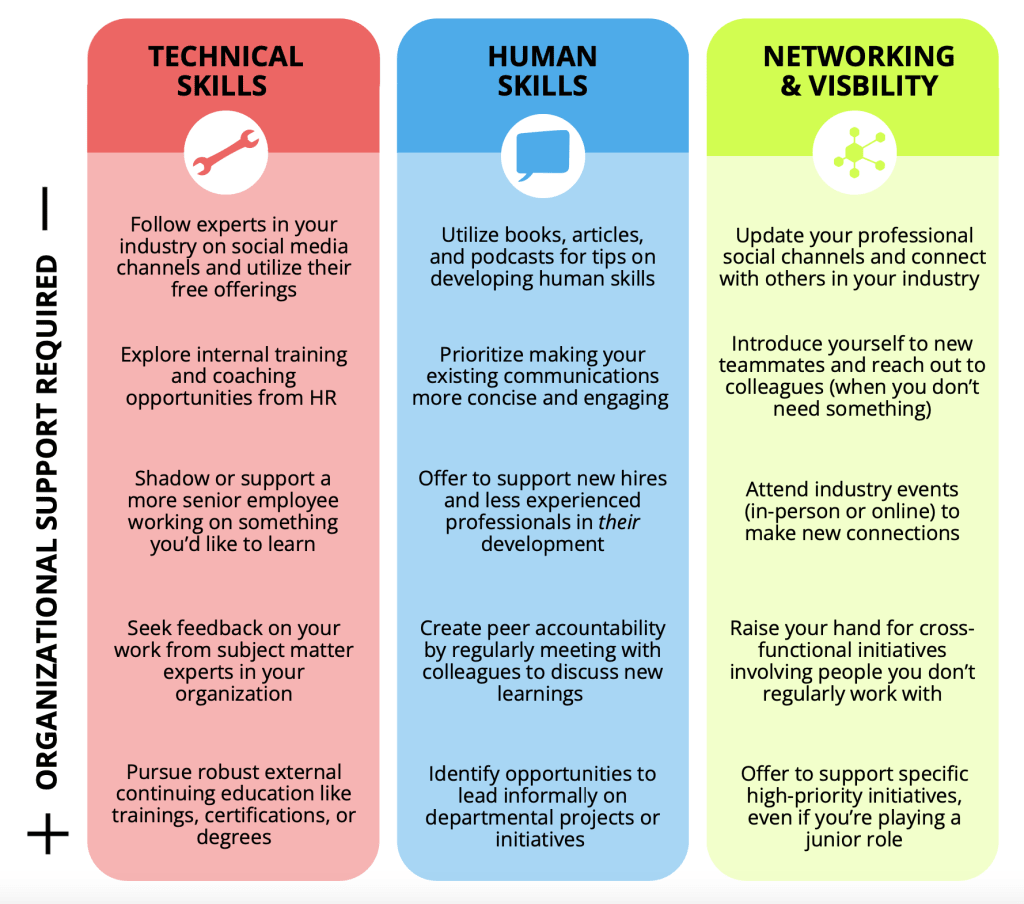How to get the growth opportunities you want at work
Research tells us that high performers thrive on challenges. Stretch projects help ambitious teammates grow their skills, and cross-team initiatives offer greater visibility. Yet, managers are overwhelmed, often unable to curate the bespoke growth opportunities their teams desire. As a result, “seeking career growth opportunities” has become the number-one reason people change jobs, according to one survey by Gallup. If you want more out of your job, you’re not alone. The good news is that opportunity is possible without plunging into a challenging job market. But it’s on you to do the heavy lifting. Instead of waiting for growth opportunities to be served up, start creating them yourself. Here are three tips to get started. Define What a Growth Opportunity Looks Like for You The more specific you can be with the type of opportunity you desire, the more likely you are to get it. It’s often helpful to work backward, first identifying the outcome you seek from a growth opportunity, and then considering the viable paths to that outcome. Do you want to improve your technical skills to ensure you stay competitive? Are you focused on elevating your human skills, like leadership and communication? Is your aim to expand your visibility in the organization and develop a stronger network? When you’re clear about the endgame, you’re better able to identify growth opportunities that align with your desired outcome. You’re also more confident in saying no to opportunities that don’t sync up. Spell Out the Specifics for Your Manager Most leaders are eager to support your professional development, but they don’t have the bandwidth to curate a list of just-stretch-enough options for you. Do the heavy lifting—and make it easy for them to nod along. When you make a request to your boss for organizational resources, a financial investment, or just the agreement that you can prioritize a developmental opportunity, it’s on you to spell it out. What’s the opportunity? Why are you asking? What do you need from your boss? Take a look at the differences between these two requests. Example A: I’d like more professional development opportunities. Are there any conferences or trainings I can go to? Example B: I’ve shared with you my desire to move into a managerial role in the next two years. To ensure I’m ready, I’m making a proactive effort to develop my leadership skills. There’s a one-day conference next month specifically for leaders in our industry, called X. I would like to attend this conference to elevate my skills, network with like-minded aspiring leaders, and gain insights from other organizations in our space. The cost of attendance is Y, and I’d be out of the office for a full day. I’ve reviewed the agenda and identified the sessions that I believe will be the most relevant to the future of our organization. Can we discuss this at my one-on-one this week? Example A is cordial and valid. Example B is strategic and ambitious. Connecting your goals to what the business needs adds urgency and validity to your request. Even with a well-crafted request, the answer might be “no,” especially if your request involves a significant investment of organizational time or money. In that event, don’t walk away defeated. Reiterate the growth you’d like to achieve and why, and ask for suggestions or alternative options. Give them time to think, be open to the paths they suggest, and know that often they’ll end up saying yes to the original request if you continue to bring it up. Cast a Wide Net Frontline leaders are often stretched thin, managing large teams and their own mountain of deliverables. When your team is under pressure, your personal growth will not be top of mind for your (likely well-intended) leader. To safeguard your career trajectory, cast a wide net for growth opportunities, tapping into HR, other senior leaders, and organizations outside your own. For example, if you heard a senior leader talk about an interesting project at a town hall, reach out and offer to help. If you admire the work someone else did on a particular initiative, ask how you can be a part of the next round. You know your leader, your organization’s culture, and the line between “self-starter” and “blatant disregard for the chain of command.” If needed, run your reach-outs by your boss first. In some roles, growth opportunities are truly few and far between. Look beyond your organization to challenge your brain: volunteering, industry events, and even hobby-based pursuits will wake up your mind and put you back in the driver’s seat. Waiting for a senior leader to tap you on the shoulder and dub you ready for growth opportunities can cost you years of momentum. The power is in your hands to create the opportunities you want in the job you already have.

Research tells us that high performers thrive on challenges. Stretch projects help ambitious teammates grow their skills, and cross-team initiatives offer greater visibility. Yet, managers are overwhelmed, often unable to curate the bespoke growth opportunities their teams desire.
As a result, “seeking career growth opportunities” has become the number-one reason people change jobs, according to one survey by Gallup.
If you want more out of your job, you’re not alone. The good news is that opportunity is possible without plunging into a challenging job market. But it’s on you to do the heavy lifting.
Instead of waiting for growth opportunities to be served up, start creating them yourself. Here are three tips to get started.
Define What a Growth Opportunity Looks Like for You
The more specific you can be with the type of opportunity you desire, the more likely you are to get it. It’s often helpful to work backward, first identifying the outcome you seek from a growth opportunity, and then considering the viable paths to that outcome.
Do you want to improve your technical skills to ensure you stay competitive?
Are you focused on elevating your human skills, like leadership and communication?
Is your aim to expand your visibility in the organization and develop a stronger network?
When you’re clear about the endgame, you’re better able to identify growth opportunities that align with your desired outcome. You’re also more confident in saying no to opportunities that don’t sync up.

Spell Out the Specifics for Your Manager
Most leaders are eager to support your professional development, but they don’t have the bandwidth to curate a list of just-stretch-enough options for you. Do the heavy lifting—and make it easy for them to nod along.
When you make a request to your boss for organizational resources, a financial investment, or just the agreement that you can prioritize a developmental opportunity, it’s on you to spell it out. What’s the opportunity? Why are you asking? What do you need from your boss?
Take a look at the differences between these two requests.
Example A: I’d like more professional development opportunities. Are there any conferences or trainings I can go to?
Example B: I’ve shared with you my desire to move into a managerial role in the next two years. To ensure I’m ready, I’m making a proactive effort to develop my leadership skills. There’s a one-day conference next month specifically for leaders in our industry, called X. I would like to attend this conference to elevate my skills, network with like-minded aspiring leaders, and gain insights from other organizations in our space. The cost of attendance is Y, and I’d be out of the office for a full day. I’ve reviewed the agenda and identified the sessions that I believe will be the most relevant to the future of our organization. Can we discuss this at my one-on-one this week?
Example A is cordial and valid. Example B is strategic and ambitious. Connecting your goals to what the business needs adds urgency and validity to your request.
Even with a well-crafted request, the answer might be “no,” especially if your request involves a significant investment of organizational time or money. In that event, don’t walk away defeated. Reiterate the growth you’d like to achieve and why, and ask for suggestions or alternative options.
Give them time to think, be open to the paths they suggest, and know that often they’ll end up saying yes to the original request if you continue to bring it up.
Cast a Wide Net
Frontline leaders are often stretched thin, managing large teams and their own mountain of deliverables. When your team is under pressure, your personal growth will not be top of mind for your (likely well-intended) leader.
To safeguard your career trajectory, cast a wide net for growth opportunities, tapping into HR, other senior leaders, and organizations outside your own. For example, if you heard a senior leader talk about an interesting project at a town hall, reach out and offer to help. If you admire the work someone else did on a particular initiative, ask how you can be a part of the next round. You know your leader, your organization’s culture, and the line between “self-starter” and “blatant disregard for the chain of command.” If needed, run your reach-outs by your boss first.
In some roles, growth opportunities are truly few and far between. Look beyond your organization to challenge your brain: volunteering, industry events, and even hobby-based pursuits will wake up your mind and put you back in the driver’s seat.
Waiting for a senior leader to tap you on the shoulder and dub you ready for growth opportunities can cost you years of momentum. The power is in your hands to create the opportunities you want in the job you already have.














![What Is a Markup Language? [+ 7 Examples]](https://static.semrush.com/blog/uploads/media/82/c8/82c85ebca40c95d539cf4b766c9b98f8/markup-language-sm.png)










































![[Weekly funding roundup June 21-27] A sharp rise in VC inflow](https://images.yourstory.com/cs/2/220356402d6d11e9aa979329348d4c3e/Weekly-funding-1741961216560.jpg)












































































































































